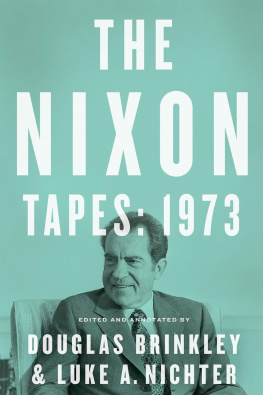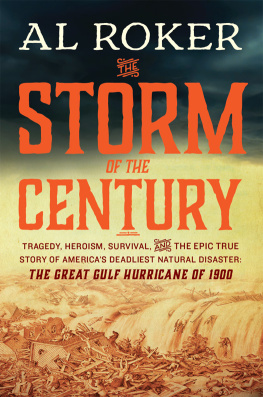Strange how people who suffer together have stronger connections than people who are most content.
I dont have any regrets, they can talk about me plenty when Im gone.
You always said people dont do what they believe in, they just do whats most convenient, then they repent.
And I always said, Hang on to me, baby, and lets hope that the roof stays on.
Bob Dylan and Sam Shepard, Brownsville Girl
I T WAS A R IPLEYS Believe It or Not! moment. Looking out the window of a fifteenth-floor condominium at One River Place on New Orleanss East Bank on August 29, 2005, I witnessed a stunning aberration. Just below me, the whitecapped Mississippi River was roaring backwardnorthwarddue to Hurricane Katrinas wrath. Earlier that morning I had left my Uptown home and evacuated vertically to this supposed safe haven. Now, as I gazed at the churning river, my miscalculation was evident. A few minutes later I took my wife and two young children to the crowded lobby, where a sense of panic ensued. A lone generator flickered on and off, while children huddled around a small refrigerator where baby bottles were stored. Storm-phobic dogs paced back and forth, their hindlegs quaking. Outside you saw everything from trembling street signs to lost umbrellas flying by as the piercing rain whipped needles and knives. You could hear glass shattering all around, and see the nearby Hilton parking garage lose its supposedly hurricane-proof roof.
A day earlier, the name Katrina had conjured whimsical images of a Gaelic ballad or a Vegas cocktail waitress. A close friend of mine, in fact, was named Katrina. There was no menace in the echo. Perhaps if the storm had been named Genghis Khan or Attila the Hun or Caligula, I would have fled. But now, as the raging Mississippi frothed with primal madness, gushing around Algiers Bend, ripping open the huge riverfront warehouses where Mardi Gras floats were stored, it was clear that Katrina was no mere hurricane or flood. It was destined to be known as the Great Deluge in the annals of American history.
Because Hurricane Katrina devastated 90,000 square miles along the heavily populated Gulf Coast, its truly impossible to capture the morose terror endured by each and every survivor. Certainly the people trapped in attics, desperately punching holes in their rooftops with axes and hammers hoping to be rescued, cannot be forgotten; theyve earned a special spot in our collective memory. Neither can the indomitable Coast Guard helicopter pilots and Louisiana Wildlife and Fisheries boatmen who hoisted stranded people out of the muck. But in the weeks after the hurricane first made landfall near Buras, Louisiana, on Monday, August 29, dozens of other horrific words and repellent images became part of our national discourse: feces contamination, storm surges, toxic soup, pervasive damage, highway triage, police suicide, FEMAs indifference, and so on.
The general feeling emanating from New Orleansat firstwas that the storm could have been worse; outside the region, this was interpreted to mean that it wasnt too bad. Once Katrina had passed, everybody patted themselves down, pleased that their vital organs were in place and that their pulse registered. Most New Orleanians who survived Katrina felt eerie, though, as if something ominous still lingered over the port city like a gothic shroud. Katrina had been a palpable monster, an alien beast that had gotten under the goose-fleshed skin of those who lived through the storm. Many of these non-evacuees felt vaguely ill that Monday evening. They sensed that something was horrifically wrong with their beloved city, something deeper than surface wounds. The ornate St. Louis Cathedral and the elegant Garden District mansions were only slightly battered, however, looking as opulent as ever. If there was a wave of post-storm optimism at first, it was because the pallid veil of Katrina had lifted, prematurely assuring residents in trickster fashion of their supposed safety. Unbeknownst at first to anyone but the Katrina victims within neighborhoods like the Lower Ninth Ward, Lakeview, Hollygrove, Gentilly, and New Orleans East, large areas of the city were goneperhaps gone forever. With the exception of WWL radio, nearly all communication within the Greater New Orleans area had broken down. People were left to rely on their own firsthand experiences, hunches, and instincts. Virtually nobody in New Orleans knew what had happened just a few lonely blocks away.
As a historian I knew a wicked hurricane could alter world history. One, in fact, prohibited Kublai Khan from conquering Japan in 1274. Somewhere along the line I had learned in a biography of Mahatma Gandhi that during World War II over 35,000 Indians were killed by a major storm just south of Calcutta. Last year, when reading Ron Chernows fine biography of Alexander Hamilton, I was reminded of how on August 31, 1772, a hurricane near the tiny island of Dominica crashed into the harbor, smashing all anchored boats and destroying the sugarcane crop. A seventeen-year-old Hamilton, traumatized by the storm, wrote an essay about it which was subsequently published in the Royal Danish-American Gazette , launching his career as a polemicist. It seemed as if a total dissolution of nature was taking place, Hamilton said. The roaring of the sea and wind, fiery meteors flying about it [sic] in the air, the prodigious glare of almost perpetual lightning, the crash of the falling house, and the ear-piercing shrieks of the distressed, were sufficient to strike astonishment into angels. I was also well aware that the great Galveston hurricane of 1900 killed between 8,000 and 10,000 people, and that when John F. Kennedy was president a tropical cyclone in East Pakistan annihilated over 22,000 citizens. Hurricanes mattered. I knew that much.














